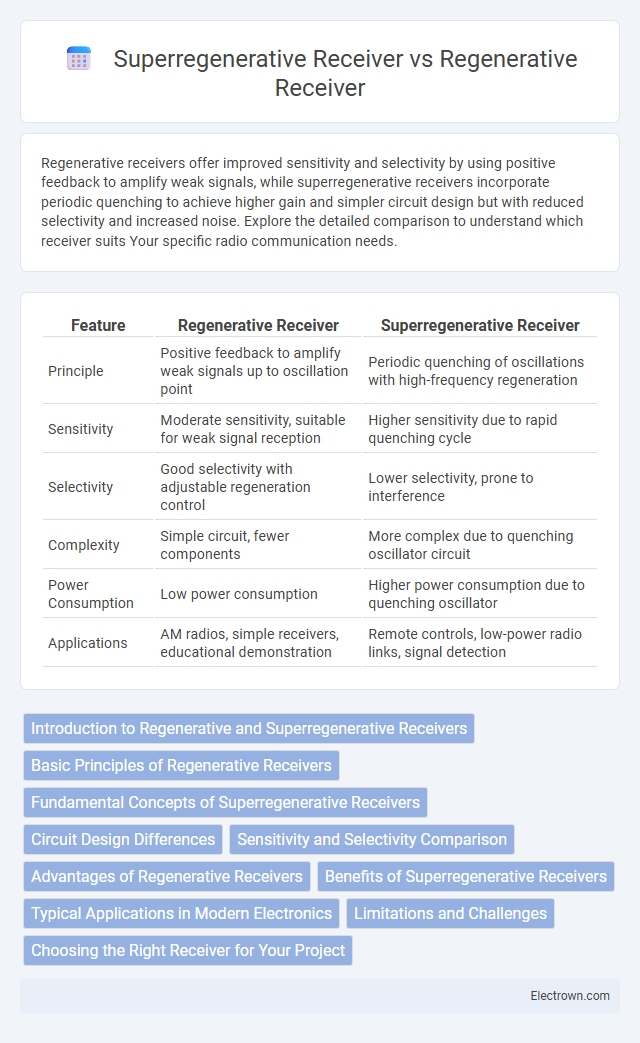Regenerative receivers offer improved sensitivity and selectivity by using positive feedback to amplify weak signals, while superregenerative receivers incorporate periodic quenching to achieve higher gain and simpler circuit design but with reduced selectivity and increased noise. Explore the detailed comparison to understand which receiver suits Your specific radio communication needs.
Table of Comparison
| Feature | Regenerative Receiver | Superregenerative Receiver |
|---|---|---|
| Principle | Positive feedback to amplify weak signals up to oscillation point | Periodic quenching of oscillations with high-frequency regeneration |
| Sensitivity | Moderate sensitivity, suitable for weak signal reception | Higher sensitivity due to rapid quenching cycle |
| Selectivity | Good selectivity with adjustable regeneration control | Lower selectivity, prone to interference |
| Complexity | Simple circuit, fewer components | More complex due to quenching oscillator circuit |
| Power Consumption | Low power consumption | Higher power consumption due to quenching oscillator |
| Applications | AM radios, simple receivers, educational demonstration | Remote controls, low-power radio links, signal detection |
Introduction to Regenerative and Superregenerative Receivers
Regenerative receivers amplify weak radio signals by utilizing positive feedback to increase gain and selectivity, making them ideal for AM and CW reception in simple and cost-effective designs. Superregenerative receivers build upon this principle by incorporating a quenching oscillator that periodically interrupts the regeneration process, significantly enhancing sensitivity and reducing quiescent current compared to regenerative designs. Understanding the fundamental operational differences between regenerative and superregenerative receivers helps you choose the right technology for applications requiring balance between sensitivity, complexity, and power consumption.
Basic Principles of Regenerative Receivers
Regenerative receivers amplify weak radio signals using positive feedback to increase sensitivity and selectivity by feeding a portion of the output back into the input, enhancing gain without significant noise addition. They rely on a single tuned circuit whose oscillation is carefully controlled just below the threshold of self-oscillation, enabling you to detect and demodulate AM signals effectively. Superregenerative receivers extend this concept with periodic quenching to achieve higher gain and simpler designs but introduce more distortion and local interference.
Fundamental Concepts of Superregenerative Receivers
Superregenerative receivers utilize a quenching oscillator to repeatedly amplify and then rapidly quench the received signal, resulting in higher sensitivity compared to traditional regenerative receivers. This quenching process enables the superregenerative design to detect very weak signals by periodically resetting the oscillation, which reduces noise and improves selectivity. The fundamental concept relies on controlling the oscillation amplitude and frequency, allowing the superregenerative receiver to achieve greater gain and minimal distortion in radio frequency signal detection.
Circuit Design Differences
Regenerative receivers use a single amplifier with feedback to enhance gain and selectivity, utilizing a controlled regeneration loop for signal amplification. Superregenerative receivers incorporate a quenching oscillator that periodically interrupts the amplification cycle, allowing for higher sensitivity and simpler circuitry. Your choice between these designs depends on the balance between signal quality and circuit complexity you require.
Sensitivity and Selectivity Comparison
Regenerative receivers achieve higher sensitivity by utilizing positive feedback to amplify weak signals without significantly increasing noise, making them effective for tuning faint transmissions. Superregenerative receivers, while offering greater sensitivity due to rapid quenching oscillations and intermittent regeneration, often suffer from reduced selectivity because the broad bandwidth of quench oscillations allows more adjacent channel interference. Overall, regenerative receivers provide better selectivity, maintaining narrower bandwidth and improved signal discrimination compared to superregenerative designs.
Advantages of Regenerative Receivers
Regenerative receivers offer superior sensitivity and selectivity by using positive feedback to amplify weak signals without significant distortion. They consume less power and have simpler circuitry compared to superregenerative receivers, making them ideal for low-cost and portable applications. Their ability to provide continuous wave operation enhances tuning precision and audio fidelity, which is advantageous in amateur radio and vintage receiver designs.
Benefits of Superregenerative Receivers
Superregenerative receivers provide significantly higher sensitivity compared to regenerative receivers due to their rapid quenching oscillations, enabling detection of weaker signals in noisy environments. They offer simpler circuit designs with fewer components, resulting in lower power consumption and reduced manufacturing costs. Their enhanced gain control and automatic frequency correction improve overall reception stability and selectivity in a variety of communication applications.
Typical Applications in Modern Electronics
Regenerative receivers are commonly used in low-power, short-range radio communication devices such as amateur radio and low-frequency signal detection due to their high sensitivity and selectivity. Superregenerative receivers find applications in wireless sensor networks, remote controls, and low-cost consumer electronics where ease of implementation and low component count are critical. Understanding the typical applications of these receivers helps you choose the appropriate technology for efficient signal reception in modern electronic systems.
Limitations and Challenges
Regenerative receivers face limitations such as frequency instability and susceptibility to interference due to their feedback control, which can cause unwanted oscillations and limit selectivity. Superregenerative receivers, while offering higher sensitivity and simpler design, encounter challenges including increased noise and distortion from their by-product oscillations, reducing audio fidelity and reception quality. Both types require careful tuning and shielding to minimize interference and maintain stable operation, restricting their use in modern complex signal environments.
Choosing the Right Receiver for Your Project
Choosing the right receiver depends on your project's sensitivity and complexity requirements. Regenerative receivers offer superior selectivity and lower noise, making them ideal for applications needing clear signal reception and moderate complexity. Superregenerative receivers provide higher gain and simpler design but may introduce more distortion, which suits projects prioritizing cost and basic signal detection over audio fidelity.
Regenerative Receiver vs Superregenerative Receiver Infographic

 electrown.com
electrown.com